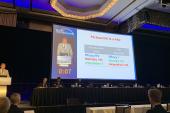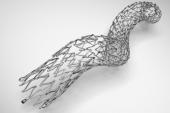BioMimics 3D Stent Holds Up Well at 3 Years in Complex PAD Lesions
These European registry data are reassuring, says Juan Granada, who noted the field continues to expand beyond DCBs alone.

MIAMI BEACH, FL—Three-year registry data show the BioMimics 3D stent performs well in femoropopliteal lesions that are long, have chronic total occlusion (CTO), or have moderate/severe calcification, according to an analysis of the MIMICS-3D study reported this week at ISET 2023.
These results and others presented here highlight the challenges of treating complex PAD, where there are an array of available options including not only stents but also drug-coated balloons (DCBs) and atherectomy.
“We know there are persistent challenges in real-world fempop lesions. The DCB pivotal trials show improved performance over angioplasty, but this isn’t a well-defined set of lesions” that reflect what’s seen in the practice setting, Robert E. Beasley, MD (Palm Vascular Centers, Miami Beach and Coral Gables, FL), said in the ISET session focused on complex PAD.
In DCB registries conducted around the world, for instance, the provisional stenting rate reaches as high as 35.5%, he said. “This is driven by lesion length, CTOs, and calcium.”
The bare-metal BioMimics 3D stent (Veryan), approved for marketing in the US in 2018 and Europe in 2012, has a helical shape designed specifically for the femoropopliteal vessel. Its shape causes “a swirling motion flow of the blood. . . . This produces elevated wall shear stress, which reduces restenosis, reduces smooth muscle cell proliferation, and reduces neointimal hyperplasia,” said Beasley, adding that the device also follows the natural movement of the fempop segment, thus decreasing localized trauma and the risk of stent fracture.
Beasley noted that there have been more than 1,750 patients treated as part of the MIMICS clinical program.
Juan Granada, MD (Cardiovascular Research Foundation, New York, NY), commenting for TCTMD, described the program as “robust,” noting that investigators weren’t “shy in including all-comers.”
But more interesting than this individual device, which Granada pointed out is not the only one designed specifically for treating femoropopliteal disease, is the larger evolution in thinking about endovascular therapies for PAD.
As reported by TCTMD, long-term data on the safety of DCBs have continued to accrue from studies like SAFE-PAD, SWEDEPAD, and VOYAGER PAD.
Now, “the biggest question is whether there are other ancillary devices or tools that could potentially increase the long-term efficacy of drug delivery technologies,” Granada told TCTMD. “A balloon is a balloon, and sometimes you actually get the effect you want with balloon dilatation, but vascular recoil and lumen loss is something you cannot prevent.
“This is where potential combination therapies, like dedicated dilatation balloon technologies or scaffolds and stents, could potentially play a role,” Granada continued. Especially in complex cases, “you’re going to need some ancillary tools to maintain the lumen open while the drug actually works.”
BioMimics 3D in Europe
The prospective MIMICS-3D registry has 3-year follow-up data for 507 patients (mean age 70.1 years; 66% male) treated at 23 European sites. Around one-quarter (24%) had critical limb-threatening ischemia (CLTI), 37% had diabetes, and 38% were current smokers.
Most lesions (57%) were total occlusions, and mean lesion length was 126 mm. Fully 53% had moderate/severe calcification, including severe bilateral wall calcification in 28%. For those with severe calcification, 59% also had CTO, and mean lesion length was 144 mm. A quarter of lesions required more than one stent (19% needed two, 4% needed three, and 2% needed four).
Outcomes were adjudicated by an independent clinical event committee. By 3 years, Kaplan-Meier estimated survival in the overall MIMICS-3D cohort was 78% (compared with 90% at 1 year and 82% at 2 years), while 3-year freedom from loss of primary patency was 71%. Just 0.4% of stents had confirmed fracture.
Propensity-matched analyses explored several aspects of complex PAD. Freedom from clinically driven TLR was similar for patients with versus without CTO (80% vs 79%) and those with none/mild versus moderate/severe calcification (76% vs 78%). Nor was there any difference between moderate (< 140 mm) and long (140-190 mm) lesions, for which freedom from clinically driven TLR was 81% and 78% at 3 years. For very long lesions (> 190 mm), the rate was 70%. “There is a slight difference between the moderate and very long lesion groups; however, the durability of the very long lesion group was impressive given the lesion length and morphology,” Beasley pointed out.
He said overall freedom from clinically driven TLR at 3 years in MIMICS-3D, despite its high average lesion length, is comparable to what has been seen for other devices, including Supera (Abbott), Zilver PTX (Cook Medical), and Eluvia (Boston Scientific).
The researchers also did a subanalysis of 2-year results for the claudication and CLTI subgroups. For the 381 patients in Rutherford class 1-3, Kaplan-Meier estimated freedom from clinically driven TLR was 92.2% at 1 year and 84.7% at 2 years. Rates were 85.1% and 76.8% at 1 and 2 years for the 121 patients in Rutherford class 4-6. By 2 years, just 20% of the claudication group had a loss of primary patency, as compared with 27.9% of CLTI group. Though these differences didn’t reach statistical significance, they did show a “slight trend towards a worse outcome in patients with CLTI,” Beasley pointed out.
Overall, the registry shows “excellent 3-year results, including those for complex patients and complex lesions,” he concluded.
Additional PAD Data
Investigators at ISET 2023 presented follow-up data from other trials in the PAD space as well:
- For the Rotarex atherectomy system (BD), 12-month results included primary patency (57.8%), freedom from TLR (71.1%), and improvement in Rutherford class (92.4%).
- Data from the LIBERTY 360 show that by 3 years, patients with chronic limb-threatening ischemia treated with orbital atherectomy fared similarly regardless of whether they did or did not have diabetes in terms of freedom from major amputation (93.3% vs 95.8%), freedom from major adverse events (62.5% vs 63.3%), and freedom from TVR/TLR (67.3% vs 65.8%).
- A subanalysis of TOBA II BTK, a study that looked at tack-optimized balloon angioplasty for below-the-knee dissections, showed that even in long lesions (mean length 152 mm; 79.3% CTOs) the treatment had 12-month amputation-free survival (94.4%), freedom from clinically driven TLR (83.3%), and freedom from all-cause death (94.4%) that matched the overall cohort.
- Five-year results from the ILLUMENATE Global registry continued to show “favorable safety and efficacy” for the Stellarex DCB (Philips), with 72.2% freedom from clinically driven TLR and 10% all-cause mortality.
- And, as previously reported by TCTMD, 24-month results from the TRANSCEND randomized trial show the SurVeil DCB (Surmodics) continued to match IN.PACT Admiral (Medtronic) for primary patency (70.8% vs 70.4%) and safety (freedom from device- and procedure-related death through 30 days and from major target-limb amputation and clinically driven TVR; 81.8% vs 83.2%).
Caitlin E. Cox is News Editor of TCTMD and Associate Director, Editorial Content at the Cardiovascular Research Foundation. She produces the…
Read Full BioSources
Beasley RE. MIMICS-3D three-year outcomes in complex lesions. Presented at: ISET 2023. January 17, 2023. Miami Beach, FL.
Disclosures
- Beasley reports consulting, research, and medical advisory board connections to Abbott, Auryon/Angiodynamics, BSCI, Cordis, Centerline BioMedical, Cook Medical, CR BARD/Becton Dickinson, CSI, Endologix, Inari, Medtronic, Merit Medical, Micro Medical Solutions, Penumbra, Philips, Terumo/Bolton, Veryan, WL Gore.





Comments